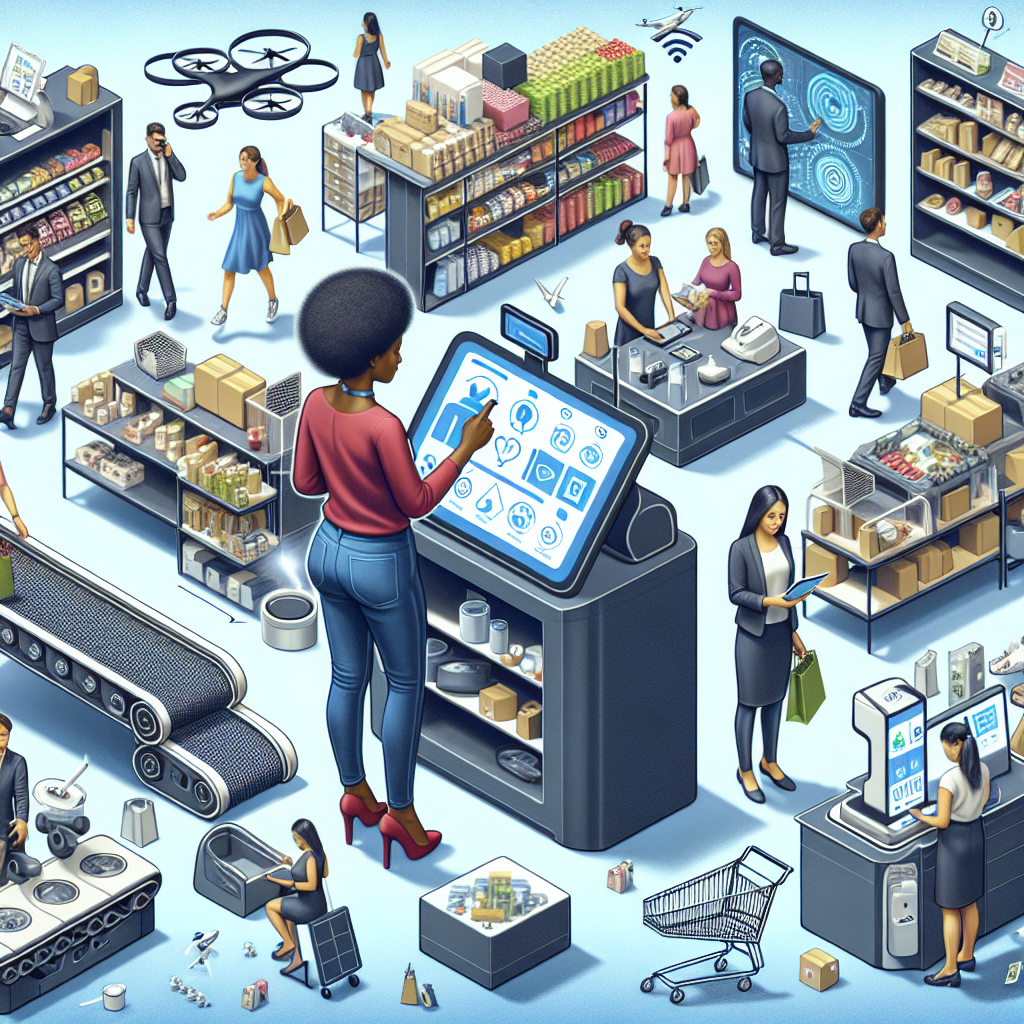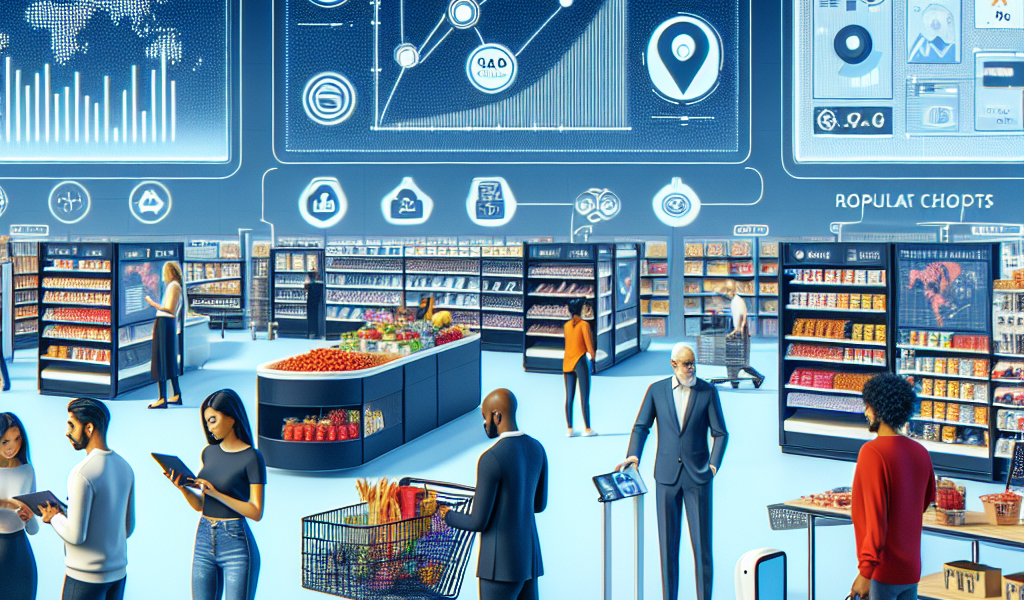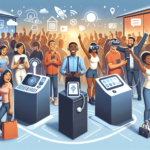-
Table of Contents
“Empowering Retail: Revolutionizing Operations Through Technology”
Introduction

The Role of Technology in Enhancing Retail Operations
In the rapidly evolving landscape of retail, technology has emerged as a pivotal force driving transformation and innovation. The integration of advanced technological solutions has revolutionized traditional retail operations, enabling businesses to streamline processes, enhance customer experiences, and optimize supply chain management. From the implementation of sophisticated point-of-sale systems and inventory management software to the adoption of artificial intelligence and data analytics, technology is reshaping the retail sector. This introduction explores the multifaceted role of technology in enhancing retail operations, highlighting its impact on efficiency, customer engagement, and competitive advantage. As retailers navigate the complexities of a digital-first world, leveraging technology becomes essential for sustaining growth and meeting the dynamic demands of modern consumers.
Leveraging Artificial Intelligence for Personalized Shopping Experiences
In today’s fast-paced retail environment, the integration of technology has become indispensable for businesses aiming to stay competitive. Among the myriad of technological advancements, artificial intelligence (AI) stands out as a transformative force, particularly in the realm of personalized shopping experiences. As consumers increasingly demand tailored interactions, retailers are leveraging AI to meet these expectations, thereby enhancing customer satisfaction and loyalty.
To begin with, AI’s ability to analyze vast amounts of data in real-time allows retailers to gain deep insights into consumer behavior. By examining purchase history, browsing patterns, and even social media activity, AI algorithms can predict what products a customer might be interested in. This predictive capability enables retailers to offer personalized recommendations, which not only improve the shopping experience but also drive sales. For instance, when a customer logs into an online store, AI can suggest items based on their previous purchases or items that are trending among similar user profiles. This level of personalization makes the shopping experience more engaging and relevant, encouraging customers to spend more time and money on the platform.
Moreover, AI-powered chatbots and virtual assistants are revolutionizing customer service in retail. These intelligent systems can handle a wide range of inquiries, from product information to order tracking, providing instant support to customers. Unlike human agents, AI chatbots are available 24/7, ensuring that customers receive assistance whenever they need it. This constant availability not only enhances the customer experience but also frees up human staff to focus on more complex tasks that require a personal touch. Additionally, AI chatbots can learn from each interaction, continuously improving their responses and becoming more adept at handling customer queries over time.
Transitioning from customer service to inventory management, AI also plays a crucial role in optimizing stock levels and reducing waste. Traditional inventory management systems often rely on historical data and manual input, which can lead to inaccuracies and inefficiencies. In contrast, AI-driven systems use real-time data and advanced analytics to forecast demand more accurately. By predicting which products will be in high demand and when, retailers can ensure they have the right amount of stock at the right time. This not only minimizes the risk of overstocking or stockouts but also reduces storage costs and waste, contributing to a more sustainable retail operation.
Furthermore, AI is enhancing the in-store shopping experience through technologies like augmented reality (AR) and smart mirrors. These innovations allow customers to virtually try on clothes or see how furniture would look in their homes without physically interacting with the products. For example, a customer can use an AR app to see how a pair of shoes would look on their feet or how a new sofa would fit in their living room. This immersive experience not only makes shopping more fun but also helps customers make more informed purchasing decisions, reducing the likelihood of returns.
In conclusion, the role of AI in enhancing retail operations is multifaceted and far-reaching. From personalized recommendations and improved customer service to optimized inventory management and immersive in-store experiences, AI is reshaping the retail landscape in profound ways. As technology continues to evolve, retailers that embrace AI will be better positioned to meet the ever-changing demands of their customers, ultimately driving growth and success in an increasingly competitive market.
The Impact of IoT on Inventory Management and Supply Chain Efficiency
The retail industry has undergone a significant transformation in recent years, largely driven by advancements in technology. Among these innovations, the Internet of Things (IoT) has emerged as a game-changer, particularly in the realms of inventory management and supply chain efficiency. As retailers strive to meet the ever-evolving demands of consumers, IoT offers a suite of tools that streamline operations, reduce costs, and enhance customer satisfaction.
To begin with, IoT devices have revolutionized inventory management by providing real-time data and insights. Traditional inventory systems often relied on manual processes, which were not only time-consuming but also prone to human error. In contrast, IoT-enabled sensors and RFID tags can automatically track inventory levels, monitor product conditions, and even predict when stock needs replenishing. This level of automation ensures that retailers maintain optimal stock levels, thereby minimizing the risk of overstocking or stockouts. Consequently, this leads to better resource allocation and improved financial performance.
Moreover, IoT technology facilitates seamless communication between various components of the supply chain. For instance, smart shelves equipped with weight sensors can alert store managers when items are running low, triggering automatic reorders from suppliers. This interconnectedness extends to warehouses and distribution centers, where IoT devices can monitor the movement of goods, track delivery vehicles, and optimize routes. By providing a holistic view of the supply chain, IoT enables retailers to identify bottlenecks, reduce lead times, and enhance overall efficiency.
In addition to improving operational efficiency, IoT also plays a crucial role in enhancing the customer experience. With the ability to track products from the point of manufacture to the point of sale, retailers can offer greater transparency and build trust with consumers. For example, IoT can provide detailed information about a product’s origin, manufacturing process, and journey through the supply chain. This level of transparency is particularly valuable in sectors such as food and pharmaceuticals, where consumers are increasingly concerned about safety and authenticity.
Furthermore, IoT technology can personalize the shopping experience by collecting and analyzing customer data. Smart devices can track consumer behavior, preferences, and purchase history, enabling retailers to tailor their offerings and marketing strategies accordingly. For instance, IoT-powered beacons can send personalized promotions to shoppers’ smartphones as they navigate through a store, enhancing engagement and driving sales. This targeted approach not only boosts customer satisfaction but also fosters brand loyalty.
However, the integration of IoT in retail operations is not without its challenges. Data security and privacy concerns are paramount, as the proliferation of connected devices increases the risk of cyberattacks. Retailers must invest in robust cybersecurity measures to protect sensitive information and maintain consumer trust. Additionally, the implementation of IoT technology requires significant investment in infrastructure and training, which may pose a barrier for smaller retailers.
Despite these challenges, the benefits of IoT in inventory management and supply chain efficiency are undeniable. As technology continues to evolve, the potential for IoT to further transform the retail landscape is immense. Retailers who embrace this technology stand to gain a competitive edge, as they can operate more efficiently, respond swiftly to market demands, and deliver a superior customer experience.
In conclusion, the impact of IoT on inventory management and supply chain efficiency is profound, offering numerous advantages that extend beyond operational improvements. By leveraging IoT technology, retailers can achieve greater accuracy, transparency, and personalization, ultimately driving growth and success in an increasingly competitive market. As the retail industry continues to evolve, the role of IoT will undoubtedly become even more integral, shaping the future of retail operations.
Enhancing Customer Engagement through Augmented Reality and Virtual Reality
In recent years, the retail industry has witnessed a significant transformation, largely driven by the integration of advanced technologies. Among these, Augmented Reality (AR) and Virtual Reality (VR) have emerged as powerful tools for enhancing customer engagement. These technologies are not just futuristic concepts; they are actively reshaping the way consumers interact with brands and products, creating immersive and personalized shopping experiences.
To begin with, AR and VR offer a unique way to bridge the gap between online and in-store shopping. Traditionally, one of the main challenges of online shopping has been the inability to physically interact with products. However, AR allows customers to visualize products in their own environment through their smartphones or AR glasses. For instance, furniture retailers like IKEA have developed AR apps that enable customers to see how a piece of furniture would look in their living room before making a purchase. This not only enhances the shopping experience but also reduces the likelihood of returns, as customers can make more informed decisions.
Similarly, VR takes customer engagement to a whole new level by creating entirely virtual shopping environments. Retailers can design virtual stores where customers can browse and interact with products as if they were physically present. This is particularly beneficial for brands that want to offer an exclusive or unique shopping experience. For example, luxury fashion brands can create virtual showrooms where customers can explore the latest collections in a highly immersive setting. This not only elevates the brand’s image but also provides a memorable experience that can drive customer loyalty.
Moreover, AR and VR technologies are proving to be invaluable in personalizing the shopping experience. By leveraging data and analytics, retailers can create customized AR and VR experiences tailored to individual preferences and behaviors. For instance, beauty brands like Sephora use AR to offer virtual try-ons, allowing customers to see how different makeup products would look on their faces. This personalized approach not only enhances customer satisfaction but also increases the likelihood of purchase, as customers can experiment with products without any commitment.
In addition to enhancing the shopping experience, AR and VR also play a crucial role in customer education and engagement. Retailers can use these technologies to provide detailed product information and tutorials in an engaging manner. For example, a home improvement store can use AR to guide customers through DIY projects, offering step-by-step instructions and visual aids. This not only helps customers feel more confident in their purchases but also fosters a deeper connection with the brand.
Furthermore, AR and VR can significantly enhance marketing and promotional efforts. Retailers can create interactive and immersive advertisements that capture the attention of potential customers. For instance, a fashion brand can develop a VR fashion show that allows customers to experience the runway from the comfort of their homes. Such innovative marketing strategies can generate buzz and excitement, ultimately driving traffic and sales.
While the benefits of AR and VR in retail are evident, it is important to acknowledge the challenges as well. Implementing these technologies requires significant investment and technical expertise. Retailers must also ensure that the user experience is seamless and intuitive, as any technical glitches can lead to customer frustration. However, as technology continues to evolve and become more accessible, these challenges are likely to diminish.
In conclusion, AR and VR are revolutionizing the retail industry by enhancing customer engagement in unprecedented ways. By offering immersive, personalized, and interactive experiences, these technologies are not only transforming the way consumers shop but also helping retailers build stronger connections with their customers. As AR and VR continue to advance, their role in retail operations is set to become even more integral, paving the way for a future where shopping is not just a transaction but an experience.
Conclusion
The role of technology in enhancing retail operations is pivotal, driving efficiency, improving customer experiences, and enabling data-driven decision-making. Advanced technologies such as artificial intelligence, machine learning, and big data analytics allow retailers to optimize inventory management, personalize marketing strategies, and streamline supply chain processes. E-commerce platforms and mobile applications have expanded market reach and provided consumers with convenient shopping options. Additionally, technologies like augmented reality and virtual reality are transforming in-store experiences, while automation and robotics are reducing operational costs and increasing productivity. Overall, technology is a critical enabler of innovation and competitiveness in the retail sector, fostering growth and adaptation in a rapidly evolving market landscape.





